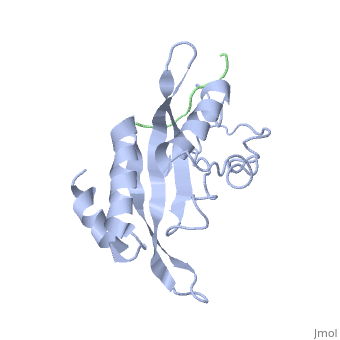1m4p: Difference between revisions
No edit summary |
No edit summary |
||
| Line 2: | Line 2: | ||
<StructureSection load='1m4p' size='340' side='right' caption='[[1m4p]], [[NMR_Ensembles_of_Models | 20 NMR models]]' scene=''> | <StructureSection load='1m4p' size='340' side='right' caption='[[1m4p]], [[NMR_Ensembles_of_Models | 20 NMR models]]' scene=''> | ||
== Structural highlights == | == Structural highlights == | ||
<table><tr><td colspan='2'>[[1m4p]] is a 2 chain structure with sequence from [http://en.wikipedia.org/wiki/ | <table><tr><td colspan='2'>[[1m4p]] is a 2 chain structure with sequence from [http://en.wikipedia.org/wiki/9hiv1 9hiv1] and [http://en.wikipedia.org/wiki/Human Human]. Full experimental information is available from [http://oca.weizmann.ac.il/oca-bin/ocashort?id=1M4P OCA]. For a <b>guided tour on the structure components</b> use [http://oca.weizmann.ac.il/oca-docs/fgij/fg.htm?mol=1M4P FirstGlance]. <br> | ||
</td></tr><tr id='related'><td class="sblockLbl"><b>[[Related_structure|Related:]]</b></td><td class="sblockDat">[[1kpp|1kpp]], [[1kpq|1kpq]], [[1m4q|1m4q]]</td></tr> | </td></tr><tr id='related'><td class="sblockLbl"><b>[[Related_structure|Related:]]</b></td><td class="sblockDat">[[1kpp|1kpp]], [[1kpq|1kpq]], [[1m4q|1m4q]]</td></tr> | ||
<tr id='gene'><td class="sblockLbl"><b>[[Gene|Gene:]]</b></td><td class="sblockDat">tumor susceptibility gene 101 ([http://www.ncbi.nlm.nih.gov/Taxonomy/Browser/wwwtax.cgi?mode=Info&srchmode=5&id=9606 | <tr id='gene'><td class="sblockLbl"><b>[[Gene|Gene:]]</b></td><td class="sblockDat">tumor susceptibility gene 101 ([http://www.ncbi.nlm.nih.gov/Taxonomy/Browser/wwwtax.cgi?mode=Info&srchmode=5&id=9606 HUMAN]), Gag ([http://www.ncbi.nlm.nih.gov/Taxonomy/Browser/wwwtax.cgi?mode=Info&srchmode=5&id=11676 9HIV1])</td></tr> | ||
<tr id='resources'><td class="sblockLbl"><b>Resources:</b></td><td class="sblockDat"><span class='plainlinks'>[http://oca.weizmann.ac.il/oca-docs/fgij/fg.htm?mol=1m4p FirstGlance], [http://oca.weizmann.ac.il/oca-bin/ocaids?id=1m4p OCA], [http://www.rcsb.org/pdb/explore.do?structureId=1m4p RCSB], [http://www.ebi.ac.uk/pdbsum/1m4p PDBsum]</span></td></tr> | <tr id='resources'><td class="sblockLbl"><b>Resources:</b></td><td class="sblockDat"><span class='plainlinks'>[http://oca.weizmann.ac.il/oca-docs/fgij/fg.htm?mol=1m4p FirstGlance], [http://oca.weizmann.ac.il/oca-bin/ocaids?id=1m4p OCA], [http://pdbe.org/1m4p PDBe], [http://www.rcsb.org/pdb/explore.do?structureId=1m4p RCSB], [http://www.ebi.ac.uk/pdbsum/1m4p PDBsum]</span></td></tr> | ||
</table> | </table> | ||
== Function == | == Function == | ||
| Line 27: | Line 27: | ||
From MEDLINE®/PubMed®, a database of the U.S. National Library of Medicine.<br> | From MEDLINE®/PubMed®, a database of the U.S. National Library of Medicine.<br> | ||
</div> | </div> | ||
<div class="pdbe-citations 1m4p" style="background-color:#fffaf0;"></div> | |||
==See Also== | ==See Also== | ||
| Line 34: | Line 35: | ||
__TOC__ | __TOC__ | ||
</StructureSection> | </StructureSection> | ||
[[Category: Human]] | |||
[[Category: Human | |||
[[Category: Alam, S L]] | [[Category: Alam, S L]] | ||
[[Category: Davis, D R]] | [[Category: Davis, D R]] | ||
Revision as of 01:05, 10 September 2015
Structure of the Tsg101 UEV domain in complex with a HIV-1 PTAP "late domain" peptide, DYANA EnsembleStructure of the Tsg101 UEV domain in complex with a HIV-1 PTAP "late domain" peptide, DYANA Ensemble
Structural highlights
Function[TS101_HUMAN] Component of the ESCRT-I complex, a regulator of vesicular trafficking process. Binds to ubiquitinated cargo proteins and is required for the sorting of endocytic ubiquitinated cargos into multivesicular bodies (MVBs). Mediates the association between the ESCRT-0 and ESCRT-I complex. Required for completion of cytokinesis; the function requires CEP55. May be involved in cell growth and differentiation. Acts as a negative growth regulator. Involved in the budding of many viruses through an interaction with viral proteins that contain a late-budding motif P-[ST]-A-P. This interaction is essential for viral particle budding of numerous retroviruses.[1] [2] [3] Evolutionary Conservation Check, as determined by ConSurfDB. You may read the explanation of the method and the full data available from ConSurf. Publication Abstract from PubMedThe structural proteins of HIV and Ebola display PTAP peptide motifs (termed 'late domains') that recruit the human protein Tsg101 to facilitate virus budding. Here we present the solution structure of the UEV (ubiquitin E2 variant) binding domain of Tsg101 in complex with a PTAP peptide that spans the late domain of HIV-1 p6(Gag). The UEV domain of Tsg101 resembles E2 ubiquitin-conjugating enzymes, and the PTAP peptide binds in a bifurcated groove above the vestigial enzyme active site. Each PTAP residue makes important contacts, and the Ala 9-Pro 10 dipeptide binds in a deep pocket of the UEV domain that resembles the X-Pro binding pockets of SH3 and WW domains. The structure reveals the molecular basis of HIV PTAP late domain function and represents an attractive starting point for the design of novel inhibitors of virus budding. Structure of the Tsg101 UEV domain in complex with the PTAP motif of the HIV-1 p6 protein.,Pornillos O, Alam SL, Davis DR, Sundquist WI Nat Struct Biol. 2002 Nov;9(11):812-7. PMID:12379843[4] From MEDLINE®/PubMed®, a database of the U.S. National Library of Medicine. See AlsoReferences
|
| ||||||||||||||||||
